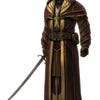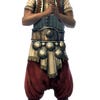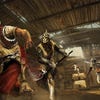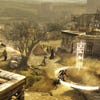Assassin's Creed: Revelations
Turkish delight on a moonlit night.
More importantly, though, it's a delight to climb. Naturally there's an achievement for reaching its peak in under thirty seconds, and scaling it at speed reveals a new, more dynamic method of traversal. "I was looking for something that upgraded navigation," says Amacio, "because I felt that navigation remained very static since Assassin's Creed 2 - whereas between Assassin's Creed 1 and 2 there was a big difference."
That something's a hookblade, a small attachment to Ezio's hidden weapon that has a profound effect on the game. Clambering up facades is that little bit quicker, the hookblade lending extra reach, while leaping from roof to roof is now that little bit more dramatic - Ezio will stretch out when flying towards a ledge before athletically pulling himself up in platforming that's got a touch of the Nathan Drakes to it. More explicitly, the hookblade works in tandem with zip-lines that course across the city lending Assassin's Creed: Revelations an effortless and efficient form of traversal.
It's also felt in the combat too, helping smooth some of the series' stilted swordplay as Ezio reaches out to sweep enemies from their feet and hooks his way from combatant to combatant. Flee from the fight and the hookblade can be used to snag nearby scaffolding, sending it tumbling down into the path of pursuers. "Our mantra was that everything we added to the game had to not only bring something new but it needed to consolidate or merge two of the major gameplay pillars," says Amacio, "That way we really reinforce the core experience."
There's added dynamism too in the storytelling, which is now less forced, more fluid and more in tune with the game world. It's a move that's been spearheaded by Amacio, a man whose last project was, interestingly, the arrestingly bold Far Cry 2. "First of all, I'm a huge fan of the Assassin's Creed series," he says, "But there was a couple of elements that I thought could not so much be improved but rather be evolved. I have a very specific view on narrative, and how we should be telling stories in games. In my opinion we should never be telling a story, we should be playing a story."
Amacio's approach sees a subtle but perceptible shift - cuts between gameplay and cinematics are now less violent, and often there's a seamless blend between the two. Sometimes it's through the West Wing walking and talking approach, Ezio walking under the player's command while a character guides him, doling out information and pointing towards the next mission at hand.
Other times the transition is slight but just as effective - Ezio's missions are now more in tune with the story, his purpose and the scope of play being brought closer together. "I feel that open world games as they become bigger and more complex are very big on the horizontal," Amacio states, "which is very good for depth but it sort of dilutes the core element, the core feeling and what exactly the meaning is of playing a specific game. The way that we're setting up the missions, making them more narrative and less systemic missions - we're trying to avoid that."
All of which may sound like anathema to those who revelled in the diversity of Brotherhood, a game that offered a wealth of diversions across its city. Revelations is no different - it even goes as far as to introduce a tower defence mini-game at one point, with Ezio commanding fellow Assassins to protect an outpost from onrushing Templars - but it's in keeping with the tone of an more mature and more responsible Ezio, a man who's now shouldering the burden of the secret war between the rival factions.
He's fronting a game that's more mature and certainly a little wiser than its forebears too. Assassin's Creed may well be reaching saturation point with its recent annual releases, but when they're as smart and polished as this we'll be sad when they're gone.









